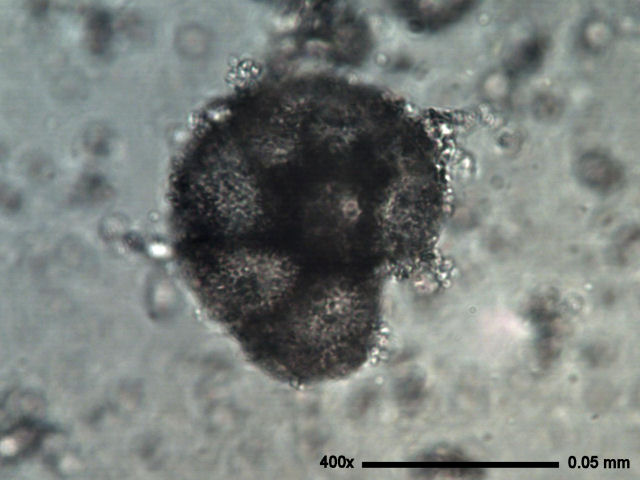Turning to the sand like material with the compound microscope I had great expectations of finding diatoms. I have
come to believe, where there is water or were there was water, there is to be
found diatoms or diatom frustules. Well, my theory about the presence of diatoms
requires some modification. After several hours and many samples not a diatom
was found. Instead I was delighted to find micro sized shells, sponge spicules
a plenty, forams, and the exciting unknown. Careful searching first at medium
power and then at high power was required but the effort was amply rewarded.

One of many microscopic foraminifera.

Foraminifera, Textularia type.

Triaxon Sponge Spicule.

Unknown 1.
Unknown 1, pictured above, was a
very exciting and puzzling find. The narrow depth of field of this picture hides
four additional bullet shaped spines jutting out toward the viewer at an angle
of approximately 30 degrees and I suspect that there are others on the reverse
side. What could this defensive object be or be a part of? Did I find and
observe a complete form or were additional spines missing?Finding
and observing is great fun but attempting to identifying these microfossils is a
real challenge for this novice.

Unknown 2.
Unknown 2 was also an exciting find. Again the limited depth
of field of this image dose not show all the bullet shaped projections. This object
strongly resembled a Christmas tree ornament of a multi faceted star. This may be a small part, possibly a siliceous spicule, of a larger host.
The tired old saying, 'one mans junk is another mans treasure', can be very true. The five shells sent to me were of no value to a fossil or shell collector. The fossil hound I acquired these from was happy to part with them and I in turn was happy to accept them. These common poor quality shells turned out to be a treasure chest of microscopic gems.

 This Web
Page Created with PageBreeze Free Website Builder
This Web
Page Created with PageBreeze Free Website Builder










![]()
![]() This Web
Page Created with PageBreeze Free Website Builder
This Web
Page Created with PageBreeze Free Website Builder
![]()
![]()